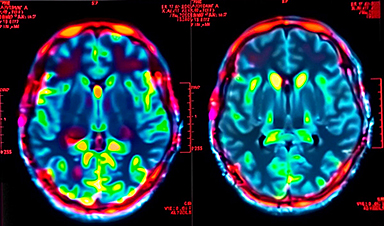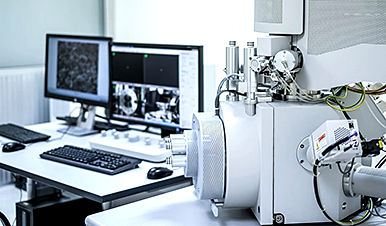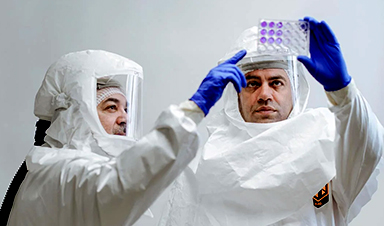A group of tiny RNA that should attack the virus causing COVID-19 when it tries to infect the body are diminished with age and chronic health problems, a decrease that likely helps explain why older individuals and those with preexisting medical conditions are vulnerable populations, investigators report.
MicroRNAs play a big role in our body in controlling gene expression, and also are a front line when viruses invade, latching onto and cutting the RNA, the genetic material of the virus, says Dr. Sadanand Fulzele, aging researcher in the Department of Medicine and Center for Healthy Aging at the Medical College of Georgia at Augusta University.
But with age and some chronic medical conditions, the attacking microRNA numbers dwindle, reducing our ability to respond to viruses, says Dr. Carlos M. Isales, co-director of the MCG Center for Healthy Aging and chief of the MCG Division of Endocrinology, Diabetes and Metabolism.
Much like not having enough troops on the ground in an actual war, the coronavirus is then better able to do what it does naturally, which is hijacking our cell machinery so it can replicate, say the researchers who report in the journal Aging and Disease what appear to be key microRNA involved in responding to this virus. They have a longer-term goal of identifying the biggest hitters and replenishing those troops.
They looked at the RNA sequence of actually two coronaviruses, SARS, which surfaced in 2002, and SARS-CoV-2, which causes COVID-19, and the sequence of the microRNAs that appeared to be attacking the virus, then used computer simulation to figure out which would logically fit together like puzzle pieces. Their perusal included four samples of SARS and 29 samples of SARS-CoV-2, taken between January and April 2020 from five continents covering 17 countries from the United States to Germany to Thailand.
They found 848 microRNAs that target the SARS genome and 873 microRNAs that target SARS-CoV-2 genome. They found 558 of the microRNAs fighting SARS also present in SARS-CoV-2, while 315 microRNAs were unique to SARS-CoV-2, and 290 were unique to SARS. MicroRNAs most proficient at attacking SARS-CoV-2 showed more than 10 target sites and might ultimately be found to be the most proficient at fighting the virus, which, in a few months, has changed much of the way the world functions.
They also found the microRNAs targeting SARS-CoV-2 were associated with more than 72 biological processes — from the production of molecules to the immune response — and that many are known to become dysregulated and/or diminish in number with age and with underlying medical conditions like diabetes and cardiovascular disease, a likely factor in the increased disease presentation and death rates seen in these individuals, the investigators say.
An example is microRNAs like miR-15b-5p, which has a high affinity for SARS-CoV-2, but is downregulated in coronary artery disease, says corresponding author Fulzele. In healthy, younger people, these microRNAs whose nature is to bind to the virus, are more apt to do as they should and prevent replication, he adds.
In the 29 worldwide samples of SARS-CoV-2, 19 had identical microRNAs, which indicates the virus has a fairly uniform presence internationally and that any effective treatments or vaccines should have broad impact, Isales says.
Next steps include studies in culture and lab animals to ensure findings are consistent with the computer analysis of human microRNAs in this study.
“The most important and striking feature of COVID-19 is the increased case fatality rate in aged individuals,” the investigators write, with the CDC reporting that nearly half of patients requiring hospitalization are age 65 and older, and these more senior individuals account for about 80% of the deaths. Fulzele, Isales and their colleagues wanted to know more about why.
“My perspective is there is a key set of microRNAs that are important in triggering this abnormal response, in making older patients more susceptible,” says senior author Isales. “We are looking at microRNAs in general dropping, but there is a specific subset that is key. The question is whether we can we target those as a therapy.”
Cocktails of multiple key microRNA, potentially given through the nose, might help restore sufficient levels of the key virus fighters, the investigators say.
They already are moving toward producing synthetic microRNA that could supplement this frontline weakened by age or disease, Fulzele says. Future studies also include pinning down which microRNA would be most impactful as an adjunct therapy, for example with the drug remdesivir, under study now for COVID-19, which works to stop the virus’ pirating of healthy cell machinery.
Another question to pursue is whether some younger people, who also are seriously sickened by SARS-CoV-2 infection, already don’t make sufficient numbers of some of the key protective microRNA, Isales says.
Image Credit: Envato/Amanda Scott
Thanks to Heinz V. Hoenen. Follow him on twitter: @HeinzVHoenen
News This Week
Does COVID increase the risk of Alzheimer’s disease?
Scientists discover that even mild COVID-19 can alter brain proteins linked to Alzheimer’s disease, potentially increasing dementia risk—raising urgent public health concerns. A recent study published in the journal Nature Medicine investigated whether both mild and [...]
New MRI Study Reveals How Cannabis Alters Brain Activity and Weakens Memory
A massive new study sheds light on how cannabis affects the brain, particularly during cognitive tasks. Researchers analyzed over 1,000 young adults and found that both heavy lifetime use and recent cannabis consumption significantly reduced brain [...]
How to Assess Nanotoxicity: Key Methods and Protocols
With their high surface area and enhanced physicochemical properties, nanomaterials play a critical role in drug delivery, consumer products, and environmental technologies. However, their nanoscale dimensions enable interactions with cellular components in complex and [...]
Nanotech drug delivery shows lasting benefits, reducing need for repeat surgeries
A nanotechnology-based drug delivery system developed at UVA Health to save patients from repeated surgeries has proved to have unexpectedly long-lasting benefits in lab tests – a promising sign for its potential to help human patients. [...]
Scientists Just Found DNA’s Building Blocks in Asteroid Bennu – Could This Explain Life’s Origins?
Japanese scientists detected all five nucleobases — building blocks of DNA and RNA — in samples returned from asteroid Bennu by NASA’s OSIRIS-REx mission. NASA’s OSIRIS-REx mission brought back 121.6 grams of asteroid Bennu, unveiling nitrogen-rich organic matter, including DNA’s essential [...]
AI-Designed Proteins – Unlike Any Found in Nature – Revolutionize Snakebite Treatment
Scientists have pioneered a groundbreaking method to combat snake venom using newly designed proteins, offering hope for more effective, accessible, and affordable antivenom solutions. By utilizing advanced computational techniques and deep learning, this innovative [...]
New nanosystem offers hope for improved diagnosis and treatment of tongue cancer
A pioneering study has unveiled the Au-HN-1 nanosystem, a cutting-edge approach that promises to transform the diagnosis and treatment of tongue squamous cell carcinoma (TSCC). By harnessing gold nanoparticles coupled with the HN-1 peptide, [...]
Global Trust in Science Is Stronger Than Expected – What’s Next?
A landmark global survey conducted across 68 countries has found that public trust in scientists remains robust, with significant support for their active involvement in societal and political matters. The study highlights the public’s [...]
Microplastics in the bloodstream may pose hidden risks to brain health
In a recent study published in the journal Science Advances, researchers investigated the impact of microplastics on blood flow and neurobehavioral functions in mice. Using advanced imaging techniques, they observed that microplastics obstruct cerebral blood [...]
AI Surveillance: New Study Exposes Hidden Risks to Your Privacy
A new mathematical model enhances the evaluation of AI identification risks, offering a scalable solution to balance technological benefits with privacy protection. AI tools are increasingly used to track and monitor people both online [...]
Permafrost Thaw: Unleashing Ancient Pathogens and Greenhouse Gases
Permafrost is a fascinating yet alarming natural phenomenon. It refers to ground that remains frozen for at least two consecutive years. Mostly found in polar regions like Siberia, Alaska, and Canada, permafrost plays a [...]
Frequent social media use tied to higher levels of irritability
A survey led by researchers from the Center for Quantitative Health at Massachusetts General Hospital and Harvard Medical School has analyzed the association between self-reported social media use and irritability among US adults. Frequent [...]
Australian oysters’ blood could hold key to fighting drug-resistant superbugs
Protein found in Sydney rock oysters’ haemolymph can kill bacteria and boost some antibiotics’ effectiveness, scientists discover An antimicrobial protein found in the blood of an Australian oyster could help in the fight against [...]
First U.S. H5N1 Death Sparks Urgency: Scientists Warn Bird Flu Is Mutating Faster Than Expected
A human strain of H5N1 bird flu isolated in Texas shows mutations enabling better replication in human cells and causing more severe disease in mice compared to a bovine strain. While the virus isn’t [...]
AI Breakthrough in Nanotechnology Shatters Limits of Precision
At TU Graz, a pioneering research group is leveraging artificial intelligence to drastically enhance the way nanostructures are constructed. They aim to develop a self-learning AI system that can autonomously position molecules with unprecedented precision, potentially [...]
How Missing Sleep Lets Bad Memories Haunt Your Mind
Research reveals that a lack of sleep can hinder the brain’s ability to suppress unwanted memories and intrusive thoughts, emphasizing the importance of restful sleep for mental health. Sleep deprivation has been found to [...]






















